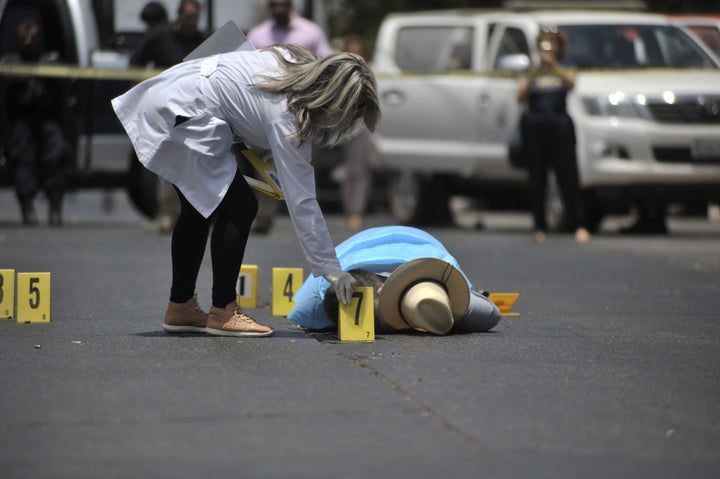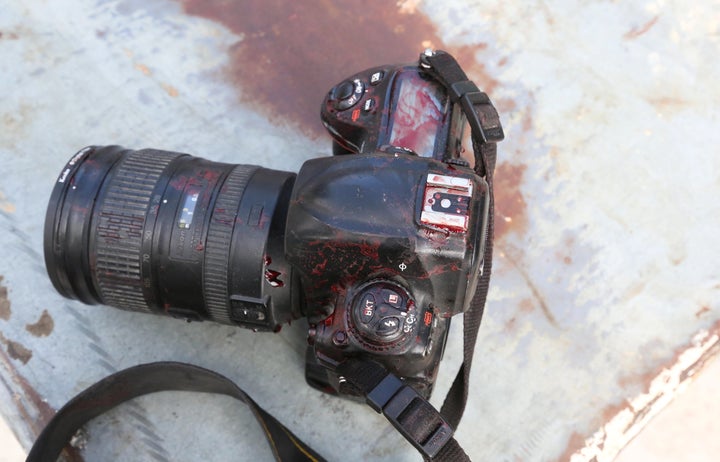Gumaro Perez, a Mexican journalist in his mid-30s, arrived at an elementary school in the eastern state of Veracruz on Tuesday morning to enjoy a Christmas celebration with his 6-year-old son.
He was dead before noon. Two gunmen burst into the building and opened fire, according to local media reports, shooting Perez four times in a classroom filled with dozens of children.
Perez had covered criminal issues, including drug trafficking, for a variety of Mexican news outlets. His death brings to 12 the number of journalists slain in retaliation for their work over the past year in Mexico ― the world’s most dangerous country to be a reporter outside of active war zones. Mexico’s 2017 death toll for professional media workers is now on par with that of Syria, which has been mired in brutal civil war for nearly seven years.
Reports released this week from Reporters Without Borders, also known as Reporters Sans Frontières (RSF), and the Committee to Protect Journalists (CPJ), reveal an overall decline in the killings of journalists worldwide in 2017 compared with previous years. But both organizations warn that some of the reasons for this downward trend are not cause for celebration.

Reprisal Killings
RSF counted 50 professional reporters killed in the line of duty ― its lowest tally in 14 years ― in addition to the deaths of 15 citizen journalists and media workers. CPJ recorded 42 intentional slayings of journalists, the lowest such number since 2008.
Both RSF and CPJ, which conduct their research independently, had listed Syria and Mexico among the deadliest countries when their reports were published on Tuesday and Thursday, respectively.
The decrease of press worker deaths this year could be due in part to greater global efforts to protect reporters, but has also been driven by journalists’ self-censorship. Fearful for their lives and safety, many are fleeing dangerous nations or changing professions, which fuels a cycle of impunity for press freedom predators.
“Impunity for journalists’ killings begets more killing.”
- Barbara Trionfi, executive director of the International Press Institute
Authoritarian regimes have also cracked down on dissent by detaining and thus silencing their critics, which has also contributed to fewer deaths in 2017.
“It’s a relief to see a drop in the number of annual deaths and we hope it marks an end to the overall global trend in recent decades of increasing killings,” said Barbara Trionfi, executive director of the International Press Institute, which also published the findings of its research into journalist deaths on Tuesday.
“Nevertheless,” she continued, “the brutal murders of so many journalists this year in Mexico and so many other countries tragically show how impunity for journalists’ killings begets more killing.”
As its drug crisis rages on, Mexico has become a hotspot for the disappearances and deaths of journalists ― especially those who work to uncover injustice and high-level corruption. CPJ’s 2011 International Press Freedom Award honoree, investigative reporter and editor Javier Valdez, was dragged from his car and shot dead in the northern city of Culiacán in May. He had written a series of books about the victims of Mexico’s cartel violence.
At least one journalist, Pakistani blogger Samar Abbas, disappeared in 2017 and remains missing today. Bangladeshi reporter Utpal Das, whose whereabouts had been unknown since Oct. 10, was found alive in the central region of Adhuria on Tuesday. He was reportedly abducted and held captive by unidentified assailants.
Both CPJ and RSF found that the number of female journalists killed in 2017 at least doubled since last year.

Reporters Behind Bars
The number of reporters incarcerated for their work hit a record high this year, according to another recent CPJ report. It found that 262 journalists were jailed as of Dec. 1. For the second year in a row, more than half of those detained are being held in just three countries: China, Egypt and Turkey, with the the latter country imprisoning the most journalists.
Turkish President Recep Tayyip Erdoğan unleashed a stifling campaign to muzzle dissenters in the wake of a failed military coup in July 2016. His regime has directed mass arrests of journalists and the sudden closures of several newspapers over the past year. With a stronger grasp on power than before, Erdoğan described the attempted takeover as “a gift from God” just days after it happened.
More than 1 in 4 imprisoned reporters worldwide is locked up in Turkey. Each is being investigated for “anti-state” crimes, according to CPJ.
In Egypt, where 20 journalists are being held, a new, draconian anti-terrorism law has tightened the government’s strangling grip on the press. Some reporters spend years in detention without being charged or tried, according to RSF.
And under President Xi Jinping’s leadership, the state of free speech has drastically worsened in China, where 41 journalists are imprisoned, per CPJ. Many media workers detained there were arrested after making coerced confessions, RSF notes.
Two Reuters reporters have now spent more than a week behind bars in Myanmar. Burmese officials apprehended Wa Lone and Kyaw Soe Oo on Dec. 12, after the two men had been invited to meet with police officials in the city of Yangon.
The journalists had been covering the conflict in the state of Rakhine, where hundreds of thousands of the Rohingya Muslim minority have fled to escape violent, state-sponsored persecution. The pair were taken into custody for allegedly intending “to send important security documents regarding security forces in Rakhine State to foreign agencies abroad,” according to Myanmar’s information ministry. They face charges under the colonial-era Official Secrets Act, with a maximum jail sentence of 14 years.
The U.S. embassy in Myanmar called for the immediate release of the journalists, following their “highly irregular” arrests.
“These arrests come amid a widening crackdown which is having a grave impact on the ability of journalists to cover a story of vital global importance,” said Shawn Crispin, CPJ’s senior Southeast Asia representative.

Journalists Held Hostage
Forty-four professional journalists are being held hostage by armed groups around the world, in addition to seven citizen journalists and three media workers ― a modest increase from last year’s figures, RSF reports.
They are all trapped in war zones: 29 in Syria, 12 in Yemen, 11 in Iraq and two in Ukraine. Extremist groups like the so-called Islamic State and al-Qaeda are responsible for dozens of abductions. ISIS lost major ground in Iraq and Syria this year, and it is unclear what happened to the reporters being held hostage in the group’s former strongholds of Mosul and Raqqa.
The exact number of journalists in captivity is difficult to calculate, RSF noted, because their families and colleagues often prefer not to report their disappearance for fear of disrupting negotiations and delaying their release.
As best the organization can determine, three journalists in Syria have been held there for more than five years: U.S. reporter Austin Tice, Jordanian journalist Bashar al-Kadumi and British journalist John Cantlie, who has been used by his ISIS captors as a tool for media propaganda.
